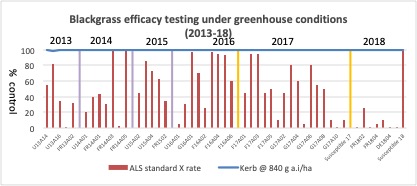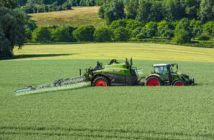Resistance monitoring studies conducted by Corteva Agriscience over many years have shown that the level of weed control of both blackgrass and ryegrass by Kerb (propyzamide) has remained consistent, while the efficacy of the ALS and ACCase herbicides has declined.
All the tests, including the most recent in 2018, demonstrate that this control remains consistent regardless of the resistance status of the weed populations tested. The graph below shows the percentage control from Kerb and a cereal ALS reference graminicide (at recommended field rates per hectare), on blackgrass populations from the UK, France and Germany sampled between 2013 and 2018.
Grass-weed resistance has been a challenging issue in the UK for many decades and it is now a major problem in virtually all arable rotations. According to the Herbicide Resistance Action Committee (HRAC), herbicide resistance is defined as the naturally occurring ability of some weed biotypes in a weed population to survive a herbicide treatment that should, under normal circumstances control that weed.
In the field it is a numbers game whereby the herbicide does not control a resistant weed and so selects out resistant survivors in a population. If the same herbicide, or one with the same mode of action is used again, it will lead to more and more individuals being selected creating a resistant population.
There are two basic types of resistance in the UK. Enhanced metabolism is when a resistant plant can degrade the herbicide to non-phytotoxic metabolites faster than a sensitive one (shown by fop chemistry in blackgrass). Whilst it is not an absolute resistance, it is the most widespread mechanism in blackgrass and can be overcome if the herbicide is applied to a small actively growing plant. The second type of resistance is more serious as it is absolute and its mechanism is called target site (ALS inhibitor groups have this type of resistance). Here the herbicide can no longer bind to its normal site of action. The build-up of this type of resistance can be rapid and has become more significant with the increase in use of ALS herbicides such as mesosulfuron-methyl +iodosulfuron-methyl-sodium in wheat.
Herbicide resistant blackgrass was first detected in the UK in 1982, resistant Italian ryegrass in 1990 and resistance wild oats in 1993. Propyzamide in the form of Kerb 400 has been on the market since 1976, and in combination with aminopyralid in ASTROKerb since 2014 and there is still no resistance to this residual-acting herbicide or any shift in sensitivity.
Propyzamide is a soil active systemic herbicide. It is a member of the benzamide chemical family (HRAC Group K) and has a multi-site mode of action with more than one binding site in the weed, explaining why weed resistance has not developed. It is a residual herbicide which can be applied from October 1st onwards when temperatures are around 10ºC and falling and soil is moist. By applying it under these circumstances the herbicide does not degrade rapidly and better weed control results.
The comprehensive proof that there is no resistance to Kerb confirms that it is has become an even more important tool in the long term management of resistant grass-weeds.
Cereal growers can use it in their winter oilseed rape for the control of annual grass-weeds including ALS and ACCase resistant population of blackgrass and ryegrass across their farms.




